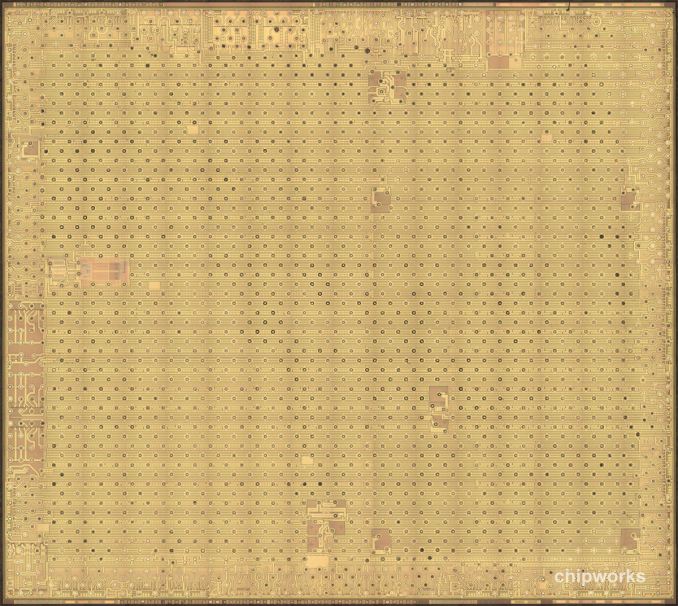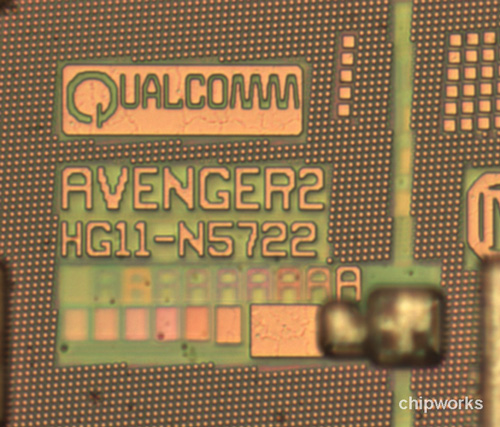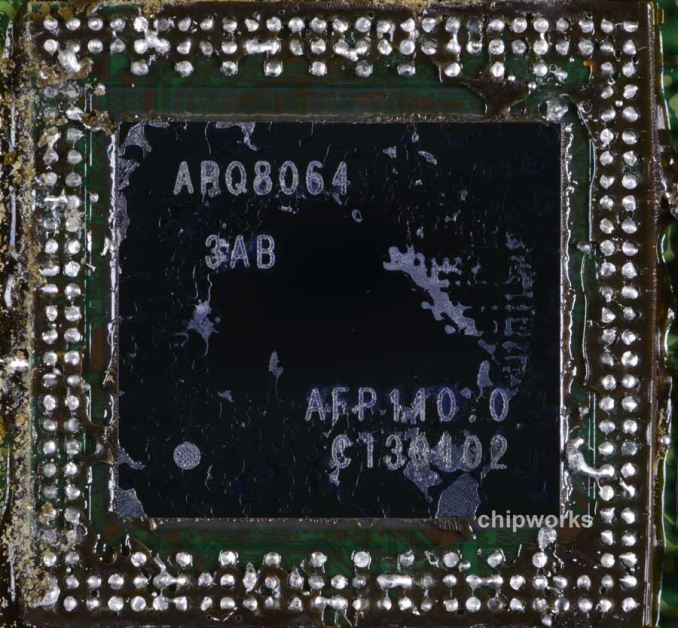Samsung Galaxy S 4 Review - Part 1
by Brian Klug on April 24, 2013 12:01 AM ESTGalaxy S 4 - Powered by a Better Snapdragon 600 (APQ8064AB)?
At a high level, Samsung's Galaxy S 4 integrates Qualcomm's Snapdragon 600 SoC. From what Qualcomm told us about Snapdragon 600, we're dealing with four Krait 300 cores and an Adreno 320 GPU. The Krait 300 cores themselves are supposed to improve performance per clock over the original Krait CPU (Krait 200) through a handful of low level microarchitectural tweaks that we've gone through here. The Krait 300 design also allegedly improves the ability to run at higher frequencies without resorting to higher voltages. This isn't the first time we've talked about Snapdragon 600, but since then a few things have come to light.

Snapdragon 600 from HTC One - Chipworks
For starters, Chipworks got their hands on a Snapdragon 600 SoC (from an HTC One) and delayered the SoC. In its investigation, Chipworks discovered that Snapdragon 600 had the exact same die area as the previous generation Snapdragon S4 Pro (APQ8064). Also, although you'd expect APQ8064T markings on the chip itself, the part carried the same APQ8064 label as previous S4 Pro designs.

Avenger 2 Markings on Snapdragon 600 die from HTC One - Chipworks
Chipworks did note however that there were some subtle differences between a standard APQ8064 and the Snapdragon 600 SoC from the HTC One. The Snapdragon 600 from the One is labeled with an Avenger2 codename rather than Avenger, the latter was apparently present on prior APQ8064 designs. Chipworks also noticed differences in the topmost metal layer, although it's not clear whether or not they stopped there or found no differences in lower layers.
All of this points to a much more subtle set of physical differences between APQ8064 and the earliest Snapdragon 600s. Metal layer changes are often used to fix bugs in silicon without requiring a complete respin which can be costly and create additional delays. It's entirely possible that Krait 300 was actually just a bug fixed Krait 200, which would explain the identical die size and slight differences elsewhere.
That brings us to the Galaxy S 4. It's immediately apparent that something is different here because Samsung is shipping the Snapdragon 600 at a higher frequency than any other OEM. The Krait 300 cores in SGS4 can run at up to 1.9GHz vs. 1.7GHz for everyone else. Curiously enough, 1.9GHz is the max frequency that Qualcomm mentioned when it first announced Snapdragon 600.
Samsung is obviously a very large customer, so at first glance we assumed it could simply demand a better bin of Snapdragon 600 than its lower volume competitors. Looking a bit deeper however, we see that the Galaxy S 4 uses something different entirely.
APQ8064 from a Snapdragon 600 based HTC One - Chipworks
Digging through the Galaxy S 4 kernel source we see references to an APQ8064AB part. As a recap, APQ8064 was the first quad-core Krait 200 SoC with no integrated modem, more commonly referred to as Snapdragon S4 Pro. APQ8064T was supposed to be its higher clocked/Krait 300 based successor that ended up with the marketing name Snapdragon 600. APQ8064AB however is, at this point, unique to the Galaxy S 4 but still carries the Snapdragon 600 marketing name.
If we had to guess, we might be looking at an actual respin of the APQ8064 silicon in APQ8064AB. Assuming Qualcomm isn't playing any funny games here, APQ8064AB may simply be a respin capable of hitting higher frequencies. We'll have to keep a close eye on this going forward, but it's clear to me that the Galaxy S 4 is shipping with something different than everyone else who has a Snapdragon 600 at this point.











335 Comments
View All Comments
CoryS - Friday, April 26, 2013 - link
Eh, I actually think phones are getting too thin. I put a case on my GS3 because I kept fumbling it due to how thin it was.nerdstalker - Wednesday, April 24, 2013 - link
What's with the QUALCOMM 4G sticker on the top bezel of the device? :sHaserath - Wednesday, April 24, 2013 - link
They're using a Qualcomm Snapdragon SOC with integrated LTE (4g)modem, I believe.nerdstalker - Wednesday, April 24, 2013 - link
Going the Intel way. :PBrian Klug - Wednesday, April 24, 2013 - link
There's been a Qualcomm 4G sticker on the top of Samsung phones since, hmm, T-Mobile SGS2 and AT&T SGS2 (Skyrocket). Even the Droid Charge/Galaxy Nexus VZW edition which had no Qualcomm parts inside did, ostensibly due to some part of the OFDMA/LTE stack being licensed for CMC221, but that was never made clear.-Brian
nerdstalker - Wednesday, April 24, 2013 - link
Interesting. Thank you for the info.ranblv - Wednesday, April 24, 2013 - link
Idon't care about removal battery, I do however care about expandable storage. carrying an extra 32GB micro sd card in my wallet saved the day many times when I needed to shoot video or transfer docs.Great review, I don't always care that much for the minor details but I like it that someone like you is making sure they deliver what they say they do.
janosch.from.afar - Wednesday, April 24, 2013 - link
cannot understand why HTC cant simply add a tray to its smartphone side to insert a battery and sd card. Much like the iphones do it with their sim card tray.Besides, samsung could simply allow two sdcard slots, instead of one - but they should try to improve the SdExtcard mount first, so to being able install all software to it.
UpSpin - Wednesday, April 24, 2013 - link
It adds further parts to the bill list, makes the frame less sturdy because you have to drill a huge hole in the side, you have to add some mechanism to lock it and you have to route all wires on the opposite side, because the battery tray side gets lost for antenna, wires, parts. With plastic it's easy because you can bent the back and remove the whole back, with aluminum it's more difficult, you have to use screws.But I agree, it's still possible. For example they could have used some screws to attach the back. It might have looked even better with screws than without them, but easy swapping won't be possible, so it has little use at all and few people really take advantage of battery swapping, so they probably just risked it with a fixed battery.
And a sd-card could have fitted easily, just as you can exchange the sim card. But here again, it's important for some (I would like one, too), but the majority gets confused with a second storage which is more likely to fail and which can't get used like the internal one, and few understand this.
holyanan - Wednesday, April 24, 2013 - link
I have to say that the browsing time is really disappointing, i fail to understand why iphones provide with supposedly twice as much browsing time - which is one of the primary functions of a phone nowdays.